A Visual History of April O’Neil, Part 6: Miscellanea
Before we head of to our exploration of the Nickelodeon era–with its three new (white) versions of April, and, more importantly given the subject matter of this series, IDW’s color reprints of old Mirage issues–I want to devote this section to some random stuff: additional images, information on related concepts, and clarifications on some of my thinking on the various topics dealt with here.
When I look at things like the cover for TMNT #11, part of me thinks that April is unquestionably African American; her hair alone is enough to make me wonder just who people who claim that she isn’t are trying to fool. Yes, artificially curly hair was popular with some white women in the eighties. One look at Google, though, is enough to show that there is a vast difference between that hair and what April is sporting, and that what April’s ‘do is not just curly, but kinky, in a way that immediately connotes blackness. It’s pelo malo, the sort of hair that has been vilified for centuries precisely because it’s association with African peoples, and is still policed today.
And yet, the part of me designed to think “it’s more complicated than that” is uncomfortable with making that assertion, and with the idea of giving April a racial identity at all that her creators have not explicitly given her.
Assigning a specific identity to someone who has not assigned it to themselves is a fraught business. It is inherently aggressive, an assertion that you know someone better than they know themselves, and that people can be reduced to simple, monolithic labels. What’s more, certainty is never guaranteed. Yes, there may be a surplus of evidence that may lead one to believe, for example, that a trans woman isn’t actually a woman, from her body to her birth certificate to the insistence of the people around her, and yet, none of that matters in the end: asserting that she’s a woman makes her one.
Now, there are obvious differences between assigning a specific identity to an actual person, and doing the same to a fictional character; April O’Neil will not be harmed by anything I claim in this series. Still, the exercise remains loaded enough that I am not entirely comfortable indulging in it, particularly when it comes to race. While it would be perfectly accurate to say that April’s physical features from issue #4 onwards–namely, darker (but very rarely dark) skin, coiled hair, and full lips–code her as African American, asserting that these things make her Black would by definition also assert that blackness–and racial identity in general–can be reduced to the sum of one’s physical features. And yet this is not the case: if April were real, none of those things would be the things that would make her Black, and not possessing one or two or even all three of those features wouldn’t mean her blackness is any less plausible or real. Yes, many Black women look like April in the cover to issue #11; many others look like Rashida Jones. Although their experiences will be much different from those faced by, say, Lupita Nyong’o or Laverne Cox, is does not make their identities any less valid.
Additionally, the fact that April is the sort of person who could pass as white (and is fact considered to be so by many) means that claiming she isn’t carries some additional historical bagagge. What I’m doing has been done before, with the specific intent of harming people of color who chose to pass as white as a survival mechanism. And while my intentions could not be more different, intent counts for very little, and the similarity still gives me the heebie-jeebies, particularly since I’m not sure I’m the person who should be bringing up these arguments in the first place.
I’m a mixed-race Puerto Rican from mixed-race parents. While I could truthfully claim Black ancestry, claiming a Black identity is another matter altogether. While far too dark-skinned for people to think I’m white, I’m too light-skinned and straight-haired for people to think I’m Black; if I’m asked where I’m from–I apparently don’t look Puerto Rican, either–people usually mention places like the Middle East («Iraq» was a high school nickname) or South Asia. While modern Puerto Rican society often discriminates on the basis of race and color, our anti-Black racism was not shaped by slavery and segregation the way the mainland’s is, meaning the cultural touchstones that affect the lives of African Americans and give them a common background to draw from are not my cultural touchstones. I have been taught to see blackness is an ingredient in the recipe for Puerto Ricanness, but not as part of my identity, much in the way flour is not cake. While I don’t quite believe that metaphor holds, asserting Blackness still feels dishonest, and something I’m not comfortable doing without giving things a great deal more thought.
And so. I’d feel much more comfortable claiming a specific identity for April if that identity were also my own; at least then I could say that I’m speaking from personal experience and not feel like I’m talking out of my ass. But that’s not the case, and so I mostly end up feeling like a lawyer.
So why am I doing this at all?
- Because I genuinely believe that April’s physical features, as depicted in issues #4 to #50 were drawn with the intent of having her be read as Black.
- Because I don’t believe these portrayals are accidental.
- Because the idea of creators coding a character as a Person of Color and then pretending it never happened is not at all farfetched—see “Evedeen, Katniss”.
- Because narratives where a Woman of Color gets to be The Normal One are necessary, and it pisses me off that April, coincidentally or not, started looking a whole lot more white when it came time for her to actually get some focus.
- Because IDW is whitewashing the heck out of those old issues.
- Because I want to see an adaptation that depicts April as a woman of color (and Casey, too, except for the fact that the whole vigilante thing only really works if he is white), and existing precedent makes it marginally more likely.
Still, there are lines which I wish not to cross, and I have been trying my best not to cross them. I have been hesitant to make any value judgments about individual images, because it is not my place to claim that a particular image does or does not accurately represent a specific type of person, and because it’s incredibly hard to draw specific conclusions based on a single drawing. Instead, what I’m doing is presenting patterns, and making a case for the argument that hey, these things are not accidental and don’t just exist in a vacuum. That color reprint of issue #32 isn’t just a fluke, but is the natural conclusion of a series of creative decisions going back years. However, if it turns out that what I think I’m doing is not what I’m actually doing, and that I’ve crossed a line in my attempts to make my case, I would like to know.
* * * *
One thing that has gone unmentioned so far is the various April action figures that have been produced over the years. While relevant to the visual evolution of April, action figures are not an area of expertise, so I have been quietly ignoring them. Still, this doesn’t mean it’s not an interesting topic, so it’s very much a good that a post on the various April action figures from 1987 to 1996 exists.
* * * *
I mentioned on the first post that despite my attempts at being comprehensive, I was still missing several relevant images of April. These are some of those, which I have come across since the beginning this project.
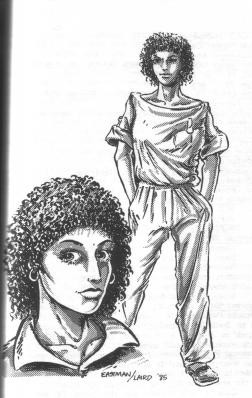
Image from TMNT & Other Strangeness RPG sourcebook (1985). Art by Kevin Eastman and Peter Laird. Image obtained from Adam Winter’s Photobucket Album.

TMNT #4, as reprinted in color for First Comics’ TMNT: Book II (June 1987). Pencils by Kevin Eastman and Peter Laird. Image obtained from iFanboy.com.

TMNT #6, as reprinted in Color for First Comics’ TMNT Book II (June 1987). Pencils by Kevin Eastman and Peter Laird.

TMNT #6, as reprinted in Color for First Comics’ TMNT Book II (June 1987). Pencils by Kevin Eastman and Peter Laird.
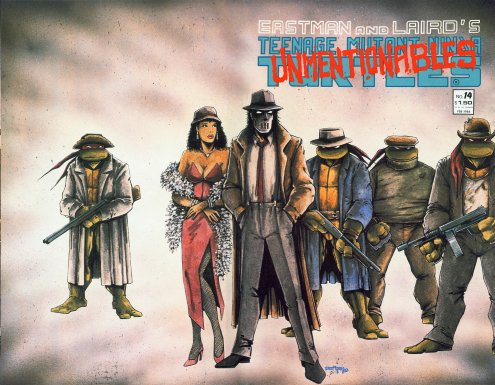
TMNT (Vol. 1) #14 (May1988) cover. Art by Kevin Eastman. Image scanned from Kevin Eastman’s TMNT Artobiography.

Cover for TMNT: The Collected Book Volume One (March 1990). Art by A.C. Farley. I’d already posted this before, but I’m reposting it because this is a much better version of the image, and also to note that I originally misattributed this to Kevin Eastman. Image obtained from MyComicShop.com.
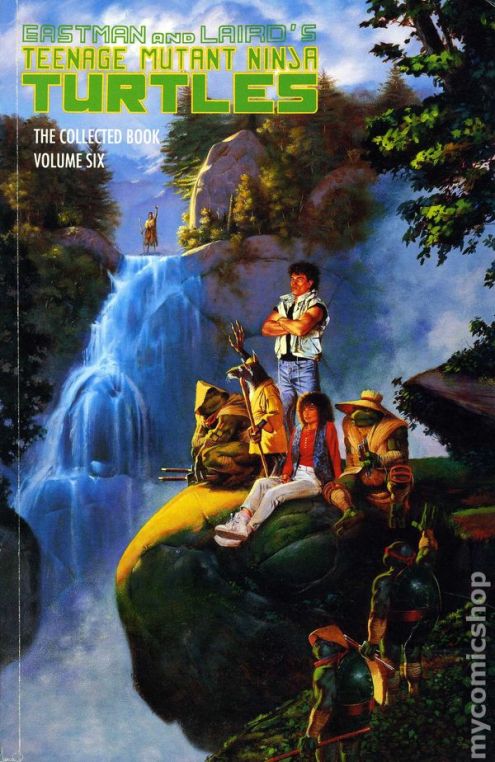
Cover for TMNT: The Collected Book Volume Six (July 1991). Art by A.C. Farley. Image obtained from MyComicShop.com.
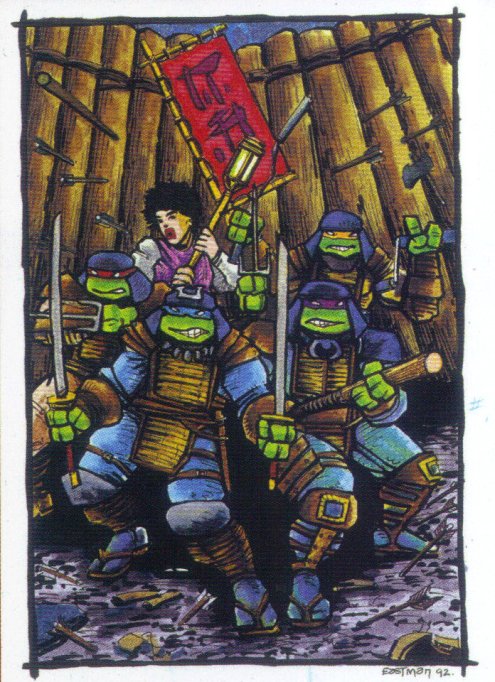
TMNT III Study (1992), as reproduced in . Art by Kevin Eastman. Image scanned from Kevin Eastman’s TMNT Artobiography.
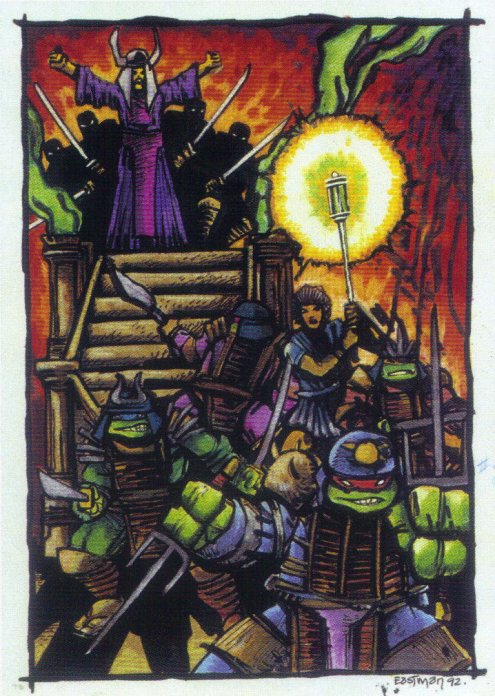
Study for the TMNT III adaptation (1992). Art by Kevin Eastman. Image scanned from Kevin Eastman’s TMNT Artobiography.
* * * *
Extra: On Lucindra
If we consider Mirage April to be African American, she would be one of only a handful of Black characters in the series, and I want to take a moment to write a bit about one of the others.

Turtle Soup (Vol. 2) #1 (November 1991). Art by Rick Arthur. Colors by Justin Hampton. Image obtained from Turtlepedia.
The woman in the above images is Lucindra Thompkins, who made a couple of appearances during the guest-creator era of the Mirage books. Unlike April, Baxter Stockman and many a Black character in contemporary mainstream fiction, Lucindra’s race plays an vital role in her characterization, and is not just something to be brought up for jokes or deemphasized. Not only does she appear to be a vital part of her mostly Black community, the iconography which she uses to decorate her apartmentappears to indicate that her Blackness and ancestry are important to her.
Why is this at all relevant? First, because one of the arguments against interpreting April as Black is that the way she is shaded / toned is both incredibly variable (true) and inscrutable (sometimes true). However, one thing that hasn’t been noted is that if white characters can sometimes be shaded in a way that makes their skin tone look darker than it really is, Characters of Color can just as equally be depicted with shading that makes their skin color seem lighter than it would be in color, as in the images above. While as far as I know Rick Arthur never drew April, it’s not hard to imagine how he would depict her, given that her skin tone is considerably lighter than Lucindra’s.
The second reason why I’m bringing Lucindra up is to serve as a preview of something we’ll be exploring when we get to the IDW reprints, specifically this.
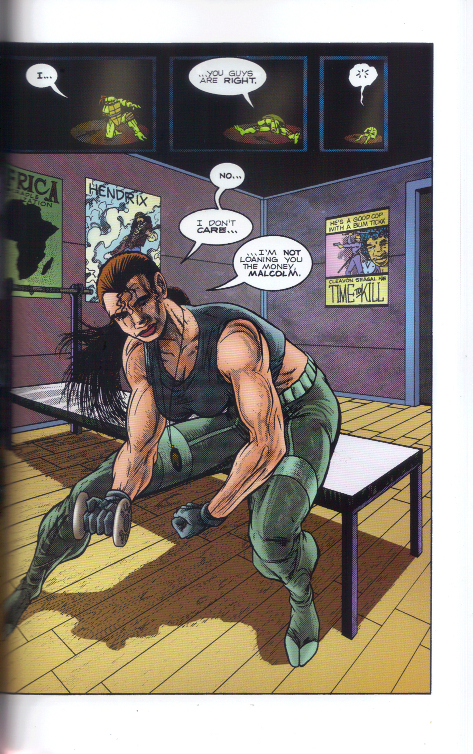
TMNT (Vol. 1) #44 color reprint, as collected in TMNT Classics Vol. 6 (Oct. 1, 2013). Colors by Digikore Design Limited.
Oh dear.
To be clear, while Lucindra as seen here isn’t any less Black, this sort of whitewashing remains problematic as all hell. Skin color is not insubstantial or trivial: the experiences of a Lucindra who looks like the one from the above picture would be completely different from those of Lucindra as she originally looked, with society in general granting a lot more privilege to the one who looks whitest while at the same time often denying her Black identity. In choosing to to alter her skin tone, the colorists not only argue that skin color is interchangeable and weightless, but also implicitly assert that a lighter skin color is aesthetically preferable and more appropriate than her original, darker hue.
Now, it’s true that the people coloring these particular reprints, Digikore Design Limited, are rather horrible at their job, pretty much choosing colors at random, with no thought given to, well, anything. Still, the fact that IDW let this sort of thing go through says a lot about the company.

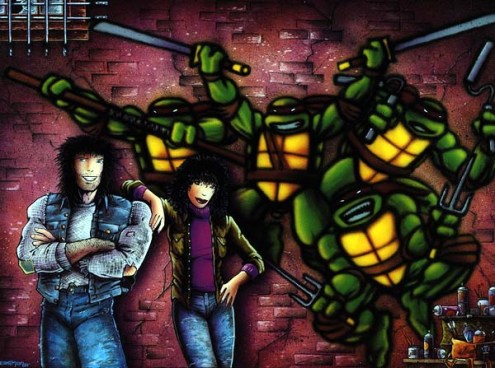

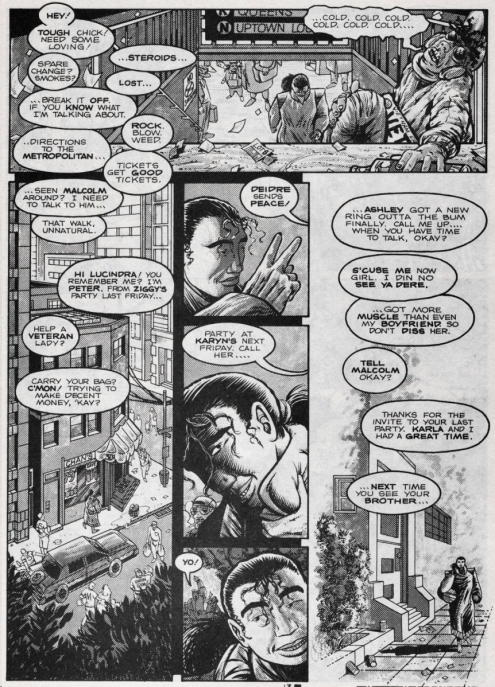
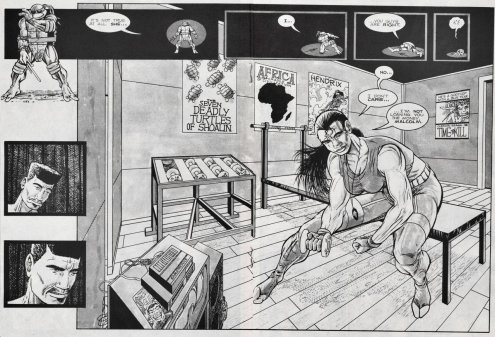
A Visual History of April O’Neil, Part 7: 2010 – 2014 | Chasing Sheep said,
agosto 7, 2014 a 6:18 pm
[…] Part 6. […]
Dr. Doom said,
agosto 12, 2014 a 12:10 am
«Oh dear.
To be clear, while Lucindra as seen here isn’t any less Black, this sort of whitewashing remains problematic as all hell. Skin color is not insubstantial or trivial: the experiences of a Lucindra who looks like the one from the above picture would be completely different from those of Lucindra as she originally looked, with society in general granting a lot more privilege to the one who looks whitest while at the same time often denying her Black identity. In choosing to to alter her skin tone, the colorists not only argue that skin color is interchangeable and weightless, but also implicitly assert that a lighter skin color is aesthetically preferable and more appropriate than her original, darker hue.»
Oh dear. You don’t know what you’re talking about. It’s problematic of you to assume that her experiences would be drastically different just because she has lighter skin. Nor does that indicate she would denied a her African American heritage. In reality she would have been criticized either way, because if she is bi-racial and she called herself black she would vilified for using the one drop rule. Even if her skin is lighter than the original she may not have experience any of the privilege that you’re talking about. In fact she probably was ostracized by both the white and black community. Also, from what I even seen her skin complexion does not look all that different from the original. For some reason you just assumed she would have darker skin. Which is odd sense it doesn’t look that way in black and white pages or in the original colorized cover. I’m afraid you’re just looking for whitewashing when there isn’t any.